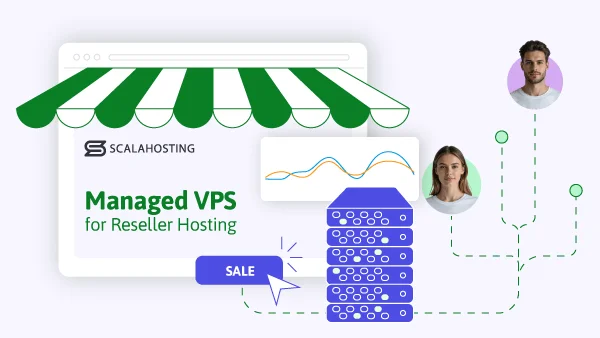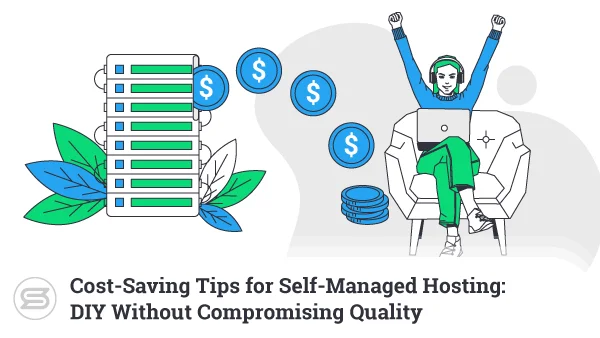Many things make a managed VPS the perfect hosting environment for your website. For one, you get guaranteed resources and your own IP, just like you would with a dedicated server. You also have near-unlimited flexibility when it comes to configuring your virtual machine, and a managed VPS service adds the extra comfort of hosting technical support.
Still, the number of different managed VPS solutions on the market is so overwhelming that novice users might struggle to find the right one.
Our mission today is to help them out…
Why Managed VPS?
First, let’s see what makes a managed VPS such an appealing proposition.
Self-managed (or unmanaged) virtual servers are tailored to people and organizations that need a custom hosting environment. Such platforms grant customers root access, meaning you can install additional third-party applications and configure the system to their exact specifications. You are also responsible for keeping the server updated and optimized at all times.
Most people can’t perform all these tasks themselves, especially if they’re unfamiliar with server management.
A managed VPS is a much more sensible choice for them.
Utilizing such a service, your hosting provider installs the operating system, deploys all tools required for hosting your website, and configures the security features. Your host also takes care of installing updates and patches and optimizing the server’s performance.
In other words, you are free to focus on building your online business without worrying about any of the technical challenges of running an entire server.
VPS Market Characteristics
There are millions of site administrators, all with their own needs and requirements. The managed VPS market is trying to satisfy as many of them as possible, and as a result, the range of options is pretty much endless.
The VPS setup itself facilitates this.
Hosting providers are free to create virtual servers with whatever hardware resources they see fit. Sometimes, the users themselves are allowed to set up a custom VPS with the exact amount of CPU power, RAM, and storage space they need.
The hardware resources are far from the only thing setting one VPS from another, though. Different technology means that two virtual servers with seemingly identical hardware configurations could put up completely different performances.
There’s plenty of options when it comes to software as well. You have a diverse choice of operating systems, web servers, and control panels, and if you don’t pick the right combination – you can affect the server’s performance and usability.
Speaking of usability, if you shop around, you’ll find hosting providers that throw in a few extra features to add more value to their service. They can offer things like an offsite backup system or free data migration for your existing projects, making for a much more hassle-free experience.
In other words, there’s plenty to think about and more than a few options to choose from.
Choosing the Right Managed VPS
To simplify the process of picking the right VPS plan, we’ll now break down the major components of any virtual server to show you what you need to focus on.
Operating System
The two most popular server operating systems are, unsurprisingly, Linux and Windows.
Windows’s popularity on desktop computers might fool some people into thinking that it’s superior to Linux when it comes to servers, as well. The truth is, Linux has a number of advantages.
An estimated 90%+ of the world’s web hosting servers run in a Linux environment, and this is not just because of the cost-effectiveness of open-source platforms.
Over the years, Linux has proven itself as a stable platform for hosting websites. Compared to Windows, it requires fewer reboots and hardware resources, meaning you can expect better loading speeds and uptime – two of the most important server performance metrics.
Because Linux dominates the web hosting industry, many of the tools required for running your website are built into it, and quite a few simply don’t support any other OS. You’ll have fewer security concerns with Linux, as well.
Web Server
The web server is the software responsible for processing visitor requests and serving the correct content. It can impact your site’s performance, so it’s important to know the type of server your host uses.
The most popular web server solutions out there are Apache and Nginx.
Apache was released way back in 1995, whereas Nginx came out in 2004. Despite being a much newer entrant on the scene, some usage statistics suggest that Nginx has already surpassed Apache in terms of popularity.
Part of this could be due to Nginx’s versatility. It can be deployed as a mail proxy, a load balancer, or an HTTP cache. In fact, site admins often use it in conjunction with Apache.
Another factor contributing to Nginx’s popularity is its asynchronous event-driven architecture. Thanks to it, you can process multiple connections under a single thread, making it less resource-intensive and faster than Apache.
That said, because it’s been around for so long, many people feel more comfortable working with Apache. In addition to this, the .htaccess file makes it more easily configurable than Nginx.
Disk Space and Storage
A Hard Disk Drive (HDD) is the traditional way of storing data on a computer or a server. You have a thin metal disk that spins at thousands of cycles per minute, and there’s a reader head that reads and writes the data.
For decades, HDDs had no alternative, but the emergence of Solid State Drives (SSDs) has turned into one of the biggest data storage innovations in recent years. The technology behind SSD is related to the one that powers your USB thumb drive. There are no moving parts, so the risk of hardware malfunction is much smaller. Crucially, SSDs read and write data up to 20 times faster than HDDs.
This boosts loading speeds, improves the user experience, and gives your site a much better chance of a good search engine ranking.
SSDs used to be prohibitively expensive, but prices have gradually dropped over the years. You can now use the technology to host your website without breaking the bank.
Many hosts now offer all-SSD storage. This is what you should be looking for if you want the best possible performance from your server hard drives.
Control Panel
One of the joys of a managed VPS is you don’t need to be a command-line ninja to manage it. Instead, you have a web hosting control panel with all the tools you need to control the projects on your server. There are plenty of free and premium control panel options, and every host decides for itself which ones it’s going to offer to its clients.
On a virtual private server, cPanel works in conjunction with WHM, a state-of-the-art server management system. Through WHM, you can monitor the VPS load, manage various built-in security tools, and create cPanel accounts for individual projects. The cPanel accounts help site administrators upload and organize files and databases, install website-building applications, create email inboxes, etc.
Cpanel has been around since 1996 and has helped millions of site owners launch their online projects. In 2019, however, cPanel announced a major change in its pricing policy and hiked the licensing fees. The jump was particularly damaging for users running multiple different projects at once, and many hosting providers started looking at the available alternatives.
At ScalaHosting, we took a different approach.
We’re convinced the best solution for our clients is a control panel specifically tailored to our managed VPS environment. This is why, for the last few years, we’ve been working on SPanel.
SPanel integrates all the tools you need to control your ScalaHosting VPS and the projects hosted on it into two separate platforms.
Through the Admin Interface, you can get information on resource usage and active processes. You can restart services or reboot the entire server with a single mouse click. The Admin interface is also where you create accounts for managing individual projects.
The User Interface lets website administrators install the CMS of their choice, upload web pages and media files, and manage databases. SPanel offers tools for editing your domain name’s DNS records, creating email accounts, and configuring many other essential settings.
We believe SPanel is the right solution for our customers, and we’ll continue to develop it with their help. We have a specialized platform where SPanel users can suggest new features and vote for those already requested. Our clients’ role in the SPanel development guarantees you’re getting a product with all useful functionalities in place.
The Importance of Technical Support
24/7 support is no longer а competitive advantage in web hosting – it is more of a standard in the industry
Here is why.
Website uptime is crucial, and when something breaks – you need to be sure you can rely on trained experts that can fix it as quickly as possible. When you manage a VPS plan, the role of your host’s support is even more significant.
For one, although your control panel gives you quite a few configuration options, you don’t always have access to all settings that can change your hosting environment for the better. For example, if you want to switch from Apache to Nginx, you have to contact your host’s support experts. Quick and efficient responses in such cases are a must.
Support agents are responsible for a lot more than handling technical requests, though. They take care of the initial setup of your managed VPS, and it’s their job to regularly optimize the server performance, apply updates, and perform regular security audits.
The support team’s work is directly related to the hosting service’s overall quality, especially when it comes to managed virtual servers.
ScalaHosting VPS Deals
Cpanel’s 2019 price hike showed everyone how huge the influence of third-party licensing fees could be on their hosting budget. A standard WHM installation with just five cPanel accounts now costs $22 per month – a price that deters hosting providers from keeping managed VPS prices on the low side.
SPanel enabled us to dramatically reduce the cost of setting up a powerful, user-friendly virtual server and offer some of the most affordable managed VPS services on the market. Here’s what our default plans look like right now:
- Start with 1 CPU core, 2GB RAM, and 20GB SSD starting from $9.95 per month
- Advanced with 2 CPU cores, 4GB RAM, and 30GB SSD starting from $21.95 per month
- Business with 4 CPU cores, 6GB RAM, and 50GB SSD starting from $41.95 per month
- Enterprise with 6 CPU cores, 8GB RAM, and 80GB SSD starting from $63.95 per month
If you wish, you can pick the hardware resources yourself to create a completely custom VPS platform and even choose which of our three data centers will host it.
Thanks to a recently signed partnership with Digital Ocean, you have even more VPS options and a choice of no fewer than eight different locations in North America, Europe, and Asia:
- DO1GB with 1 CPU core, 1GB RAM, and 25GB SSD starting from $9.95 per month
- DO2GB with 1 CPU core, 2GB RAM, and 50GB SSD starting from $15.95 per month
- DO4GB with 2 CPU cores, 4 GB RAM, and 80GB SSD starting from $31.95 per month
- DO8GB with 4 CPU cores, 8 GB RAM, and 160GB SSD starting from $67.95 per month
- DO16GB with 8 CPU cores, 16GB RAM, and 320GB SSD starting from $139.95 per month
We firmly believe that affordable managed VPS hosting with blistering performance, regular backups, and world-class support is shaping the future of our industry, and we’re working hard on bringing it as close to our clients as possible.
Conclusion
Managed VPS hosting is the perfect solution for the people who want to enjoy the benefits of having an entire server to themselves but not yet ready to tackle the task of administering it on their own.
Your project’s performance and ultimate success depend on the choice of virtual server, and with such a diverse range of solutions, picking the right one isn’t easy. It might take a while, but considering all the factors and researching the different options will definitely pay off in the end.
FAQ
Q: How do I manage my own VPS?
A: There are two types of virtual private servers – managed and self-managed.
With a self-managed server, you get a virtual machine that you need to configure yourself. It’s up to you to install the required software on it, keep it up-to-date, and optimize the server for the best possible performance.
With a managed VPS, you leave the server administration work to your hosting provider and instead focus on your online business.
Q: How do I choose a good VPS service?
A: The market offers a pretty much endless range of configurations.
First, get to know your project’s technical requirements and see which of the available options fit them. Do some due diligence on the providers that offer suitable plans and ask questions about the technology they use. Finally, read other people’s opinions and try to get as much information as possible about response times and the overall quality of the hosting providers’ support team.
Q: Do I need VPS hosting?
A: Most low-traffic websites often find affordable shared hosting plans suitable enough for their needs. Shared plans can indeed be suitable for projects in the early development stages, but if you want to really grow and evolve – VPS hosting is the way to go. The price gap between the two services has been gradually shrinking, so the savings from shared hosting may not be worth it, especially given the advantages a virtual private server brings to the table.
What is a VPS – Everything you need to know!



